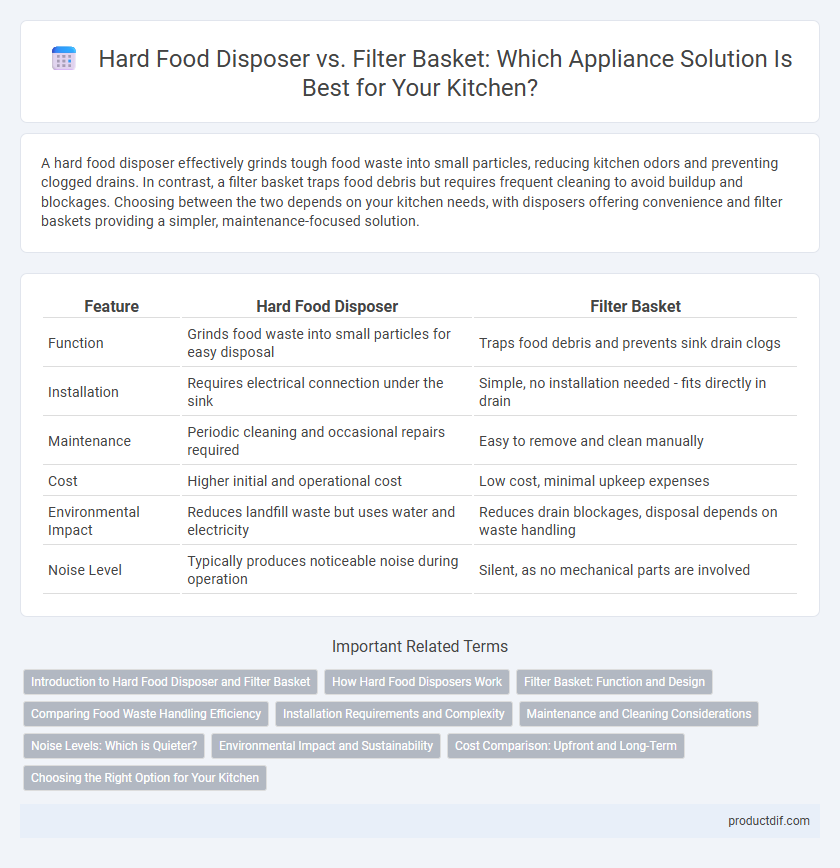A hard food disposer effectively grinds tough food waste into small particles, reducing kitchen odors and preventing clogged drains. In contrast, a filter basket traps food debris but requires frequent cleaning to avoid buildup and blockages. Choosing between the two depends on your kitchen needs, with disposers offering convenience and filter baskets providing a simpler, maintenance-focused solution.
Table of Comparison
| Feature | Hard Food Disposer | Filter Basket |
|---|---|---|
| Function | Grinds food waste into small particles for easy disposal | Traps food debris and prevents sink drain clogs |
| Installation | Requires electrical connection under the sink | Simple, no installation needed - fits directly in drain |
| Maintenance | Periodic cleaning and occasional repairs required | Easy to remove and clean manually |
| Cost | Higher initial and operational cost | Low cost, minimal upkeep expenses |
| Environmental Impact | Reduces landfill waste but uses water and electricity | Reduces drain blockages, disposal depends on waste handling |
| Noise Level | Typically produces noticeable noise during operation | Silent, as no mechanical parts are involved |
Introduction to Hard Food Disposer and Filter Basket
A Hard Food Disposer grinds food waste into small particles, preventing kitchen sink clogs and promoting efficient drainage. A Filter Basket, typically installed in sink drains, traps food debris to avoid clogging pipes while allowing water to flow freely. Both devices enhance kitchen sanitation but operate through distinct mechanisms--grinding versus filtering.
How Hard Food Disposers Work
Hard food disposers operate by using a high-speed spinning impeller to break down food waste into small particles, allowing them to drain safely through plumbing. Unlike filter baskets that trap debris and require manual cleaning, disposers grind organic material inside the unit, minimizing blockages and odors. This mechanism enhances kitchen hygiene and reduces the volume of waste sent to landfills.
Filter Basket: Function and Design
Filter baskets in kitchen sinks serve as essential strainers that trap food particles and debris, preventing clogging in the plumbing system. Designed with fine mesh or perforations, they allow water to flow freely while capturing solids, making cleanup easier and maintaining hygiene. Their durable materials, often stainless steel or plastic, ensure longevity and resistance to corrosion, aligning with efficient waste management in everyday kitchen use.
Comparing Food Waste Handling Efficiency
Hard food disposers efficiently grind and liquefy tough food waste, reducing kitchen waste volume and minimizing blocked drains. Filter baskets catch solid debris and prevent large particles from entering the plumbing but require manual disposal and frequent cleaning to maintain functionality. Comparing food waste handling efficiency, hard food disposers offer superior automated processing, while filter baskets provide a simpler but less effective waste management solution.
Installation Requirements and Complexity
Hard food disposers require professional installation involving electrical wiring and plumbing modifications, often demanding specialized tools and expertise. Filter baskets, typically designed for compact kitchens, offer simple installation with minimal tools, usually fitting directly into the sink drain without complex adjustments. The complexity difference impacts time and cost, with hard food disposers necessitating more preparation and potentially higher installation expenses.
Maintenance and Cleaning Considerations
A Hard Food Disposer requires regular inspection and cleaning to prevent clogs and odors, often involving grinding small food particles and flushing with water. Filter baskets in sinks trap debris and require manual removal and rinsing to maintain proper drainage and hygiene. Both systems benefit from routine maintenance, but disposers typically need less frequent direct cleaning compared to filter baskets, which accumulate visible residue.
Noise Levels: Which is Quieter?
Hard food disposers typically generate more noise due to their powerful motor and grinding mechanism, producing sounds ranging from 70 to 90 decibels. Filter baskets operate more quietly, usually emitting noise levels below 50 decibels since they rely on water filtration rather than mechanical grinding. For households prioritizing low noise disturbance, filter baskets offer a quieter alternative compared to the louder operation of hard food disposers.
Environmental Impact and Sustainability
Hard food disposers reduce landfill waste by grinding organic food scraps into biodegradable particles that enter wastewater systems, promoting sustainable waste management. Filter baskets, while simpler, often lead to more food waste going to landfills, increasing methane emissions and environmental impact. Choosing a hard food disposer supports eco-friendly kitchen practices by minimizing solid waste and enhancing composting efforts.
Cost Comparison: Upfront and Long-Term
Hard food disposers typically have a higher upfront cost, ranging from $150 to $500, but offer long-term savings by reducing garbage waste and minimizing costly plumbing issues. Filter baskets are cheaper initially, usually $20 to $50, but may lead to higher maintenance costs over time due to frequent replacement and potential clogging. Evaluating overall expenses reveals hard food disposers as a more cost-effective solution for durable kitchen waste management.
Choosing the Right Option for Your Kitchen
Hard food disposers efficiently grind food waste, reducing kitchen trash and preventing clogs in plumbing systems, making them ideal for households with heavy food scraps. Filter baskets capture food debris before it enters the drain, requiring manual emptying but preventing damage to pipes and disposal units, suitable for kitchens with less frequent waste disposal needs. Selecting between a hard food disposer and a filter basket depends on your kitchen's waste volume, plumbing setup, and maintenance preferences, ensuring optimal performance and convenience.
Hard Food Disposer vs Filter Basket Infographic

 productdif.com
productdif.com